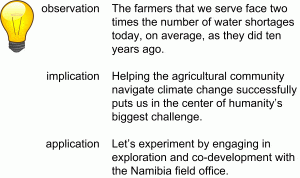Clients of mine who pursue the practice of collaborative innovation express the concern that they may become the victim of their own success.
What if they develop their practice? What if they expand their program?
What if, as a result of achieving practice and program maturity, people in their organization begin to share their ideas with one another?
What if the number of ideas grows and grows and grows beyond the organization’s ability to execute on even a small number of them?
Would not the blockage of ideas—of the ideation flow from the front to the back end of innovation—cause people to turn away from the practice and disengage from the program?
The Nature of an Idea
The clients’ concern reveals a certain lack of understanding about the nature of ideas—their malleability—and the process of ideation within the enterprise.
Let’s start with the former: the ideas as discrete objects.
As I have suggested, a fully formed idea consists of a connected set of observations, implications, and applications (figure 1). What do I see around me that cause me to have the idea? What meaning do I—or the organization at large—make of these observations? How might I test my thinking to see if the idea delivers relative advantage? An idea that lacks one or more of the critical elements is, in reality, an insight or a notion or a wild hair—but, not an idea.
Figure 1: example of a fully formed idea
Imagine for a moment that a colleague contributes a fully formed idea: an idea for a new product, for example.
Let’s say that 100 of their colleagues contribute their own ideas on the same subject.
And, let’s say that, historically, the organization finds it has the bandwidth to bring to market five (5) new products each year.
In other words, you have 20 times the number of candidate ideas as you do the ability to deliver.
What now?
If you treated each idea as a discrete action item—something to go off and explore, one after the other—you would spend the rest of your career on the work.
Almost all the people who contributed ideas would have long since left the organization—maybe not out of impatience with your ineffective methods, but you did not help matters, either. Let’s be honest.
If you attempted to increase throughput, you risk encouraging feature creep—or, in the CPG space, pointless brand extensions, which results in no value for the effort.
The Idea as Part of A Collage
Instead, rather than treat each idea as a discrete action item, treat each one as an element in a collage. Your job becomes a lot more interesting: less administrative, more envisioning. What you find in taking this approach is that certain themes arise based on what the contributors see: their observations.
The fact that, for example, 30% of the ideas observe a certain job to be done turns out to be the most important learning from the work. What satisfying that job requirement means to the organization is left to be worked out among the stakeholders. Through your practice, however, you have collapsed 30 ideas into one concept to carry forward. Imagine going through this exercise a couple times during an event: a challenge or a campaign.
Further, I find often that each theme or concept has both near and long term implications: this timing translates to business horizons, which translate to roadmaps, etc. The implication is that you often have time to test more forward-looking aspects of the larger concept—and time to learn from your near-term results, assuming your practice is sound.
Sound Process Makes for Sound Practice
The above perspective on ideas leads to the latter point: ideation process.
For the above to work, the practitioner must possess a set of consultative and facilitation skills. Can they convene a group of people to identify common themes across horizons? Can they help the group articulate what is next? Do the colleagues trust their abilities?
If not, then the temptation will be great to treat each idea as a “to do” item to be dutifully run to the ground: not as an expression of best practice, but as the result of practice immaturity.
People who want to gain the needed expertise have resources available to them such as The International Association of Facilitators (IAF) and the Association of Visual Facilitators (AVF). The jobs to be done framework, as described by the consultancy Strategyn, is a useful tool in the practitioner’s toolkit. Please feel free to contact me for ideas.
The Digital Age does not do away with the need for the dialogue by which a group of people identify and make meaning of trends, including building concepts from a pastiche of ideas that share a common set of observations. The Digital Age instead accentuates that need. We move no more quickly than we can reach shared understandings of the true nature of things, together. An overabundance of ideas indicates a lack of productive dialogue, not an unmanageable overabundance of creativity.





0 Comments